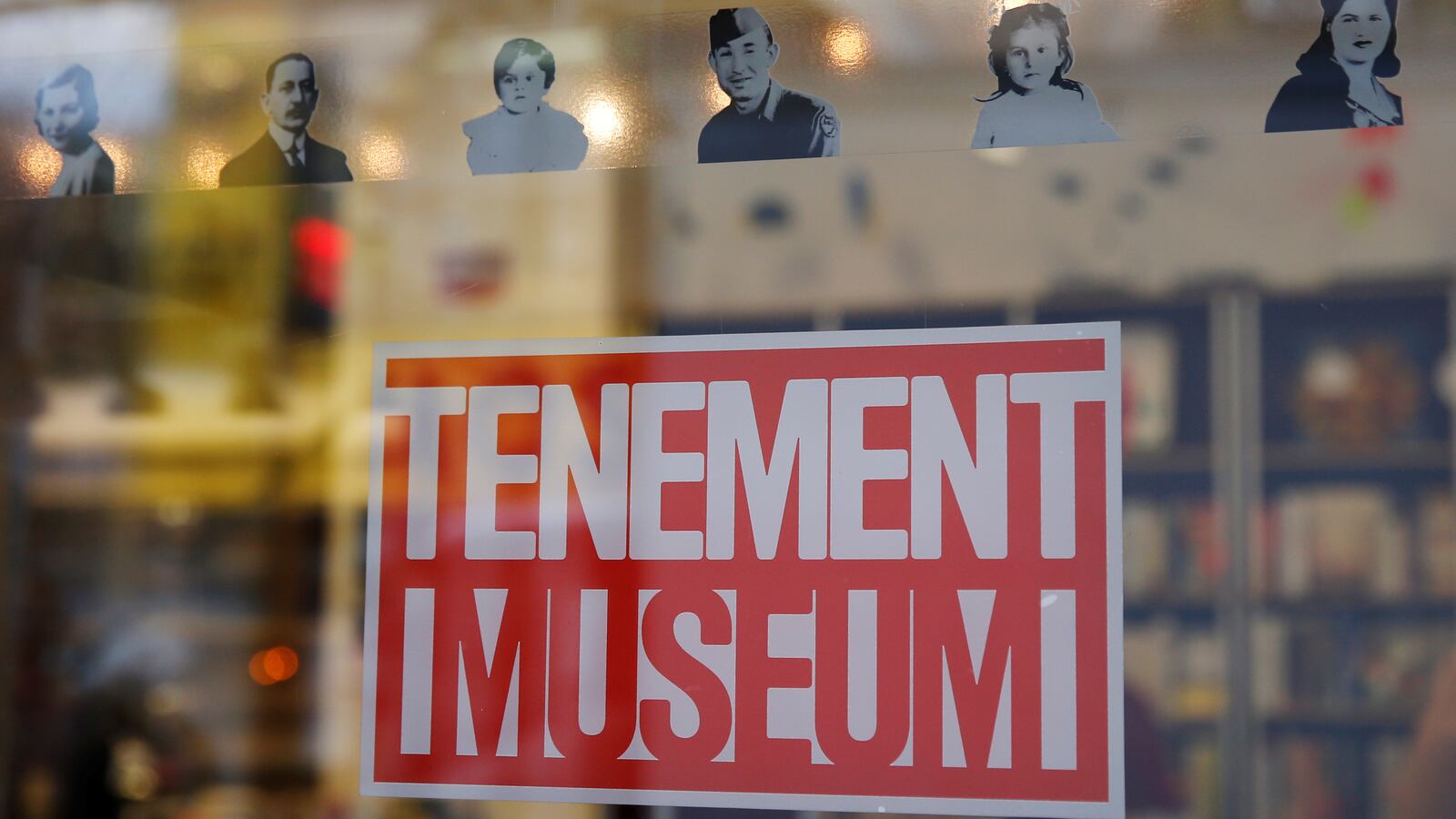An ugly battle has erupted between a prominent museum in New York City and a former employee who accused it of caving to “wokeness” by adding a Black man’s story to its exhibits, mirroring a conservative-led trend playing out in cultural institutions across the country.
The Tenement Museum in the Lower East Side became the latest target of the so-called anti-woke brigade after the ex-employee claimed that introducing the Black man’s story to museum exhibits and tours would be akin to erasing the existing stories of European immigrants. Museum directors told The Daily Beast that’s nonsense.
“It has always been part of our mission to tell complicated stories, and it’s always been part of our mission to expand the stories that we told while keeping the stories we already have,” Tenement Museum president Annie Polland told The Daily Beast.
In an essay published Sunday for The Spectator World and re-printed in the New York Post, Peter Van Buren charged that the museum, which offers historical accounts of residents who lived in one overcrowded tenement building on Orchard Street, was constructing a “big fat lie” by erasing the stories of some immigrants to appease audiences and visitors who want more diversity.
Van Buren said that he joined the museum for about a year in 2016 as an educator, the museum’s version of a tour guide. He claimed that the mission of the institution changed after Donald Trump won the 2016 presidential election. From that point on, Van Buren asserted, curators and directors focused on fighting fascism within the museum. Equating the new direction to critical race theory, Van Buren wrote that “narratives were rewritten.”
“This wokeness, which drove me to quit, is now headed for a new low in a desperate move to shoehorn a black family into the mix,” Van Buren wrote. “The museum is planning for the first time not only to feature the story of a family that never lived there but that weren’t even immigrants. They were born in New Jersey.”
“To accommodate this change,” he continued, “the museum will do away with its current Irish family tour in lieu of a hybrid to emphasize black suffering and de-emphasize the actual life experiences of discrimination imposed on the Irish by ‘whiter’ New Yorkers.”
After Van Buren’s essay went live, conservative backlash was vocal on social media. Many felt the inclusion of a Black man did not do history justice. They believed the addition of a Black family meant that a white family would have to be erased.
“The Tenement Museum was an unforgettable part of a trip to New York a few years ago,” one Twitter user posted. “But now it's being sacrificed to the gods of wokeness, because the Irish and the Jews it documented are no longer in fashion.”
“Woke??? Call it lies!” another wrote.
“Can you imagine being a poor Irish family barely surviving while facing attacks from protestants, hoping for a better future. Just to have your story rewritten to something that's not true,” someone else posted.
The Tenement Museum, which was launched in 1988, has traditionally focused on the Irish, German, Italian, and Eastern European immigrants who attempted to adapt to American life during the nineteenth and twentieth centuries. It details the rough living and working conditions during waves of immigration from the 1800s to the 1900s, as well as the various social and political biases they endured based on sex, race, ethnicity, and class.
In 2017, the museum opened another location on Orchard Street that focused on the experiences of Latino and Chinese families in the area from the 1950s to the 1980s. Along with reconstructed apartments at both locations, the museum also does local walking tours so visitors can see what life was like during the early days in ethnic enclaves in Lower Manhattan.
One of the rooms at the original location of the museum is dedicated to Joseph Moore, an Irish immigrant who worked as a waiter in the nineteenth century. The room was launched in 2008, and visitors could look through an 1869 city directory that showed his address and occupation. At the time, museum curators discovered that another Joseph Moore lived in the area during the same period and also worked as a waiter. However, he was Black. So the museum dug into his history and included information about the second Joseph Moore during walking tours.
In an interview with The Daily Beast, Polland and Kathryn Lloyd, the museum’s senior director of programs and interpretation, said the city directory was made available during tours, and visitors could ask how the Black Joseph Moore’s life compared to that of the Irish Joseph Moore.
“They’re both waiters, live less than a mile apart in Lower Manhattan. We realize this is really an essential opportunity for the museum to look at how the stories of Black and Irish New Yorkers are really intertwined in the 1860s,” Lloyd said.
In 2019, museum directors proposed creating a room dedicated to the Black Joseph Moore in the original location. Curators did not plan to erase any existing material, including the story of the Irish Joseph Moore. Instead, they said they were just making an addition. Nevertheless, Van Buren claimed in his essay that the museum was “doing away” with its Irish history.

A tour group gathers outsides the Lower East Side’s Tenement Museum.
John Moore/GettySpeaking to The Daily Beast, Van Buren, who previously worked for the U.S. State Department, didn’t back down on that claim, maintaining that the inclusion of the Black Joseph Moore somehow tarnished the institution’s mission.
“My fear is that their motivations are far from historically pure and more towards speaking to the political needs of 2021,” he said.
He compared his year working at the Tenement Museum to having a historical spiritual experience.
“The Tenement Museum was always, to me, a jewel, something very special,” he said. “Bringing in the story of some other family that neither was an immigrant nor lived in the building seems at odds with something they were doing so right.”
But Polland countered that the Tenement Museum shows that “history was complicated.”
“To be able to tell the stories about Black New Yorkers and Irish New Yorkers, which has often been told as one of contestation and with a backdrop of violence—thinking about the Draft Riots of 1863—we have the opportunity to also tell the history of shared living, shared tenement houses together, sharing households together, having children together. This was also part of the reality of New York history that hasn’t been told as much,” she said. “It’s exciting.”
The museum’s research found that the Black Joseph Moore left New Jersey for New York in 1857. At that time, there were areas in New Jersey where slavery was still legal. So, Moore left a rural, slave-holding environment to live in a state where slavery had been abolished. Though he was not an immigrant in terms of leaving one country for another, he was still embarking on a new life in a society with social norms that differed from what he was accustomed to, Lloyd said.
“He might have considered questions of where he could be safe, where he could have opportunities, questions that European immigrants might also have been considering,” Lloyd said.
But Van Buren disagreed.
“If you want to make the argument that moving from New Jersey to New York counts as immigration, that’s a stretch,” he said. “I understand what they’re trying to do, but I think it’s an example of modernism, where you’re really, really trying to interpret a historical event through a 2021 lens.
“The immigrant experience involves leaving absolutely everything you have ever known, of being desperate enough to leave everything you have ever known... and fight your way out of the status that you’re given when you cross that barrier at Ellis Island. I cannot see anyone historically claiming that was the experience from someone moving from New Jersey to Lower Manhattan.”
Polland said the museum will be “explicit” in explaining that the Black Joseph Moore and his family did not live in the Orchard Street building, but the tenement will be used as a visual recreation of what his livelihood was probably like at the time.
“From the very beginning, the museum set out—not just to have a tenement filled with Jewish stories, or just Irish stories, or just Italian stories, or just German stories—but rather as the museum grew, to keep adding,” Polland explained.
“In adding the Black story, we’re continuing the dynamic that was set up from the very beginning to tell the stories of different groups of people and how they shared the city together.”








